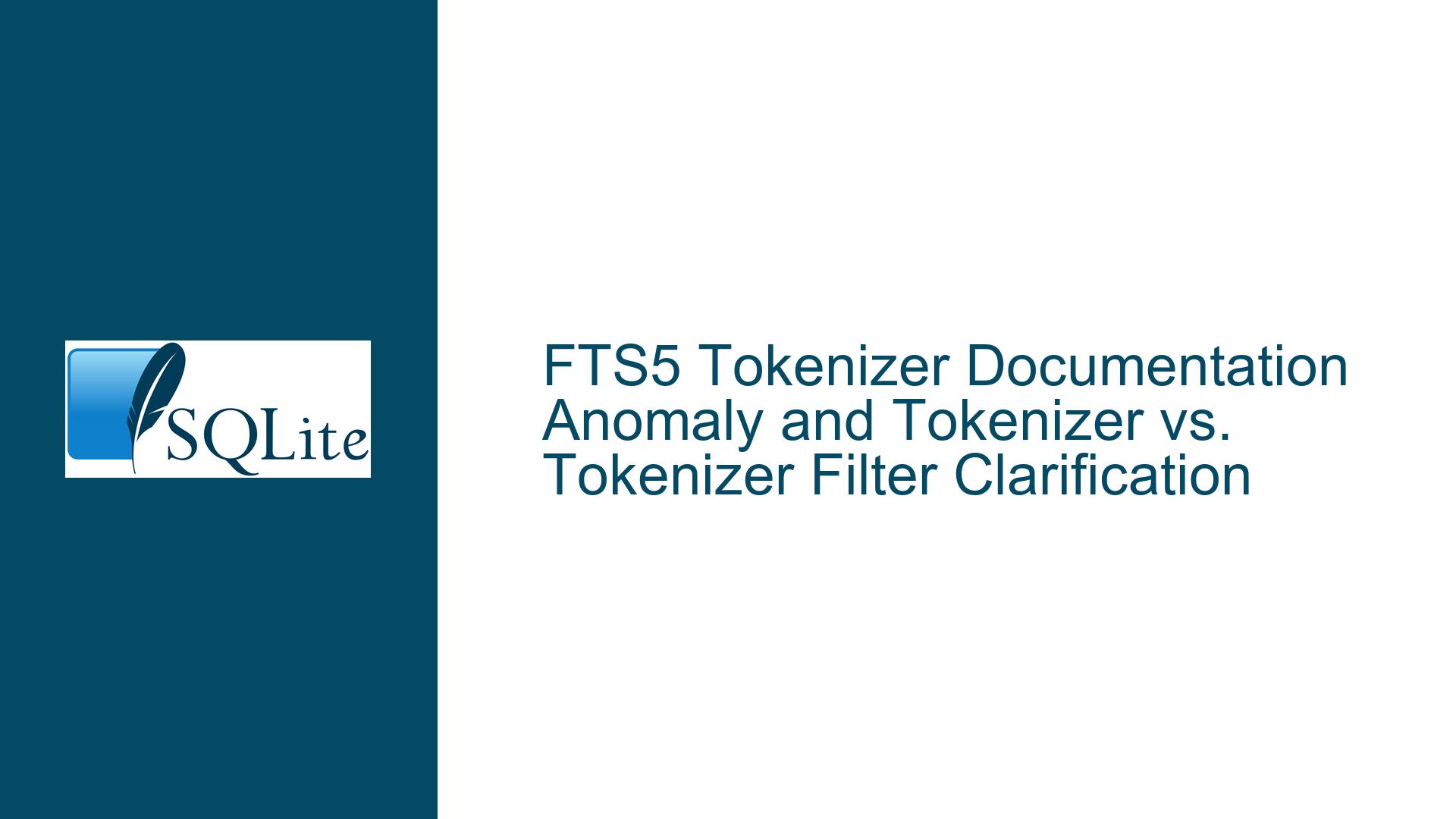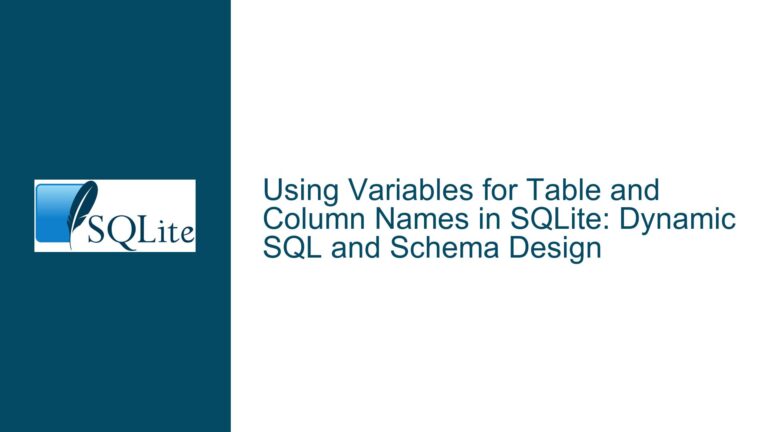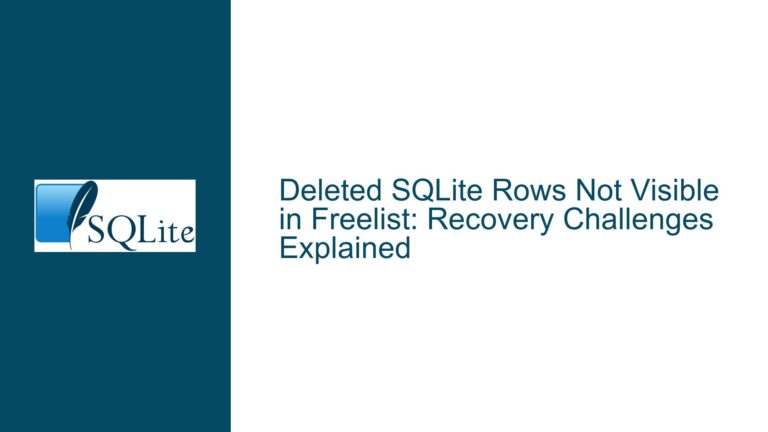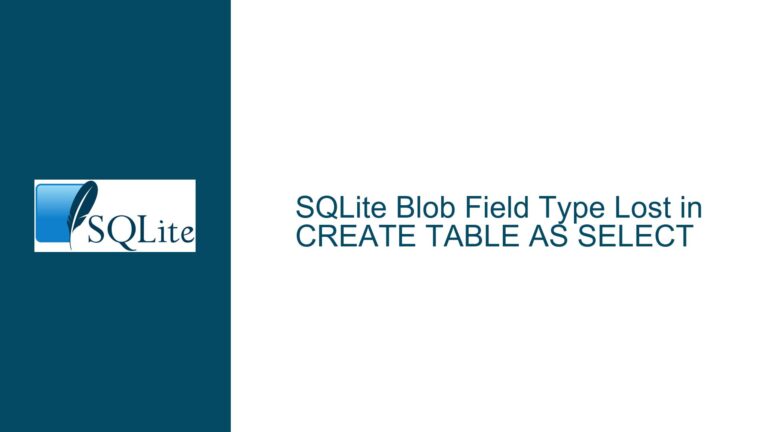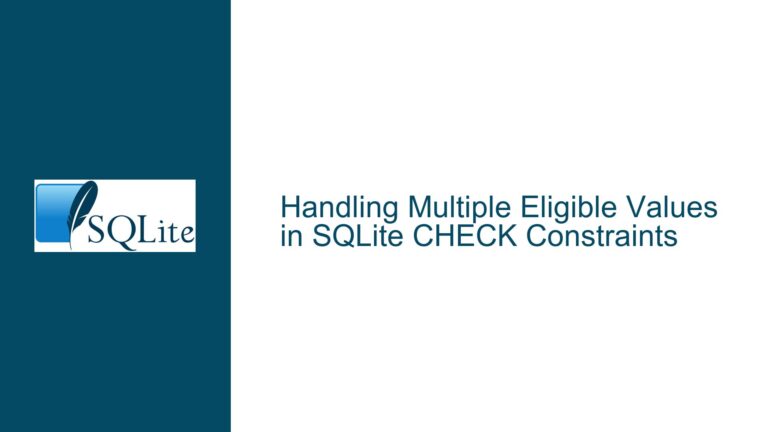FTS5 Tokenizer Documentation Anomaly and Tokenizer vs. Tokenizer Filter Clarification
Issue Overview: FTS5 Tokenizer Documentation Discrepancy and Tokenizer vs. Tokenizer Filter Confusion
The core issue revolves around two interconnected problems in the context of SQLite’s FTS5 (Full-Text Search) module. First, there is a discrepancy in the FTS5 tokenizer documentation, where the documentation initially states that FTS5 features three built-in tokenizer modules (unicode61, ascii, and porter) but later describes four tokenizers, including the ‘trigram’ tokenizer. This inconsistency can lead to confusion for users trying to understand and implement FTS5 tokenizers. Second, there is a lack of clarity regarding the distinction between a tokenizer and a tokenizer filter, which are fundamentally different components in the text processing pipeline. This confusion can hinder users from effectively leveraging FTS5’s capabilities, especially when attempting to customize or extend its functionality.
The unicode61 tokenizer, which is the default, is based on the Unicode 6.1 standard and handles text segmentation according to Unicode rules. The ascii tokenizer assumes that all characters outside the ASCII codepoint range (0-127) are to be treated as token characters, making it suitable for ASCII-only text. The porter tokenizer, often misunderstood as a standalone tokenizer, is actually a tokenizer filter that implements the Porter stemming algorithm. It modifies an existing token stream by reducing words to their root forms. The trigram tokenizer, which is not explicitly mentioned in the initial list, generates tokens by breaking text into sequences of three characters, useful for certain types of pattern matching.
The confusion between tokenizers and tokenizer filters is particularly problematic because it affects how users design their text processing pipelines. A tokenizer is responsible for converting raw text into a stream of tokens, while a tokenizer filter takes an existing token stream and modifies it. For example, the porter tokenizer filter can be applied after a unicode61 tokenizer to stem the tokens, but it cannot function independently as a tokenizer. This distinction is crucial for users who want to implement custom text processing logic, such as handling synonyms, stopwords, or case folding.
Possible Causes: Documentation Ambiguity and Conceptual Overlap Between Tokenizers and Filters
The discrepancy in the FTS5 tokenizer documentation likely stems from an oversight in maintaining consistency between different sections of the documentation. The initial description of tokenizers may have been written before the trigram tokenizer was added, and the documentation was not updated to reflect this change. This inconsistency can mislead users into believing that the porter tokenizer is a standalone tokenizer rather than a filter, especially since it is grouped with the unicode61 and ascii tokenizers in the initial list.
The confusion between tokenizers and tokenizer filters arises from the conceptual overlap in their roles within the text processing pipeline. Both components operate on text and produce tokens, but they do so at different stages and with different responsibilities. Tokenizers are responsible for the initial segmentation of text into tokens, while tokenizer filters modify or enhance these tokens. For example, a tokenizer might split a sentence into individual words, while a tokenizer filter might stem those words or remove stopwords. This overlap can make it difficult for users to distinguish between the two, especially when the documentation does not explicitly clarify their roles.
Another contributing factor is the lack of examples or use cases in the documentation that demonstrate the practical differences between tokenizers and tokenizer filters. Without clear examples, users may struggle to understand how to combine these components effectively. For instance, the documentation does not provide a step-by-step guide on how to create a custom tokenizer pipeline that includes both a tokenizer and a tokenizer filter, such as using the unicode61 tokenizer followed by the porter tokenizer filter for stemming.
The absence of a detailed explanation of the tokenizer filter concept in the FTS5 documentation exacerbates the issue. While the documentation briefly mentions that the porter tokenizer implements the Porter stemming algorithm, it does not explicitly state that it is a filter rather than a standalone tokenizer. This omission can lead users to assume that the porter tokenizer can be used independently, which is not the case. Additionally, the documentation does not provide guidance on how to implement custom tokenizer filters, leaving users to figure out this aspect on their own.
Troubleshooting Steps, Solutions & Fixes: Clarifying Tokenizer Roles and Correcting Documentation
To address the FTS5 tokenizer documentation anomaly and clarify the distinction between tokenizers and tokenizer filters, the following steps can be taken:
Update the FTS5 Documentation: The documentation should be revised to clearly state that FTS5 includes four built-in tokenizer modules: unicode61, ascii, trigram, and porter. The porter tokenizer should be explicitly described as a tokenizer filter rather than a standalone tokenizer. This clarification will help users understand that the porter tokenizer must be used in conjunction with another tokenizer, such as unicode61 or ascii.
Provide Clear Definitions and Examples: The documentation should include clear definitions of tokenizers and tokenizer filters, along with examples that demonstrate their roles in the text processing pipeline. For instance, an example could show how to create a custom tokenizer pipeline that uses the unicode61 tokenizer followed by the porter tokenizer filter for stemming. This example would help users understand how to combine these components effectively.
Explain Tokenizer Filter Implementation: The documentation should provide guidance on how to implement custom tokenizer filters, including the use of the FTS5 C APIs. This guidance should cover the creation of tokenizer filters for common tasks such as stemming, stopword removal, and synonym handling. Additionally, the documentation should explain how to maintain offsets into the source text, which is crucial for features like snippet and highlight.
Highlight Practical Use Cases: The documentation should include practical use cases that demonstrate the benefits of using tokenizer filters. For example, a use case could show how to use the porter tokenizer filter to improve search results by stemming words to their root forms. Another use case could demonstrate how to use a custom tokenizer filter to handle synonyms, such as adding "1st" when "first" is seen or "puppy" when "dog" is seen.
Provide Code Examples: The documentation should include code examples that illustrate how to use tokenizers and tokenizer filters in real-world scenarios. These examples should cover both basic and advanced use cases, such as creating a custom tokenizer pipeline, implementing a tokenizer filter for stopword removal, and using the FTS5 C APIs to extend FTS5 functionality.
Clarify the Role of the Trigram Tokenizer: The documentation should explicitly describe the trigram tokenizer and its use cases, such as pattern matching and fuzzy search. This clarification will help users understand when and how to use the trigram tokenizer effectively.
Address Common Misconceptions: The documentation should address common misconceptions about tokenizers and tokenizer filters, such as the belief that the porter tokenizer can be used independently. This clarification will help users avoid common pitfalls and make better use of FTS5’s capabilities.
Encourage Community Contributions: The SQLite community should be encouraged to contribute to the documentation by providing additional examples, use cases, and explanations. This collaborative approach will help ensure that the documentation remains accurate, comprehensive, and up-to-date.
By implementing these steps, the FTS5 documentation can be improved to provide a clearer and more accurate understanding of tokenizers and tokenizer filters. This improvement will help users make better use of FTS5’s capabilities and avoid common pitfalls, ultimately leading to more effective and efficient text processing solutions.
In conclusion, the FTS5 tokenizer documentation anomaly and the confusion between tokenizers and tokenizer filters are significant issues that can hinder users’ ability to effectively leverage FTS5’s capabilities. By updating the documentation, providing clear definitions and examples, explaining tokenizer filter implementation, highlighting practical use cases, providing code examples, clarifying the role of the trigram tokenizer, addressing common misconceptions, and encouraging community contributions, these issues can be resolved. This will enable users to better understand and utilize FTS5’s powerful text processing features, leading to more robust and efficient search solutions.
